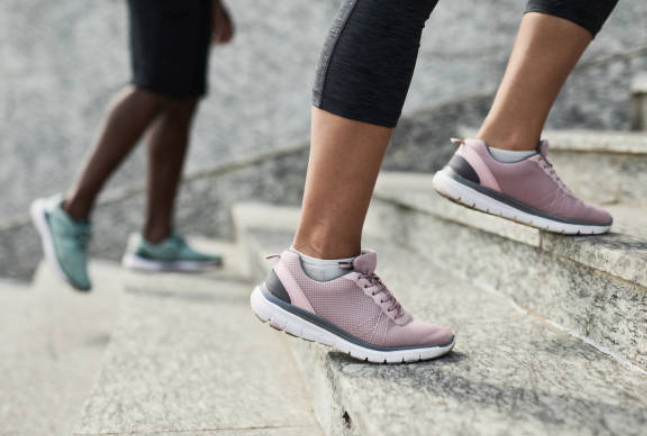Content Menu
● Introduction to Running Shoes
>> Key Differences Between Men's and Women's Running Shoes
● Benefits of Wearing Men's Running Shoes for Women
>> Example: Wider Toe Box in Men's Shoes
● Drawbacks of Wearing Men's Running Shoes for Women
>> Video: Men's vs Women's Running Shoes
● Gender Differences in Running Biomechanics
>> Study on Gender Differences in Running Biomechanics
● Super Shoes and Gender Performance
>> Super Shoes Performance Benefits
>> Impact of Super Shoes on Running Records
● Innovative Running Shoes for Women
>> Biomechanical Effects of Innovative Shoes
● Personal Experiences with Men's Running Shoes
● Future of Running Shoes
● Conclusion
● FAQ
>> 1. Can Women Wear Men's Running Shoes?
>> 2. What Are the Key Differences Between Men's and Women's Running Shoes?
>> 3. Do Women Benefit More from Super Shoes Than Men?
>> 4. How Do Gender Differences in Running Biomechanics Affect Shoe Design?
>> 5. Is It Necessary to Have Gender-Specific Running Shoes?
● Citations:
The question of whether women can run in men's shoes has sparked a lively debate in the running community. While there are clear differences in design and fit between men's and women's running shoes, many women find that men's shoes can offer benefits such as increased durability and wider widths. In this article, we will explore the benefits and drawbacks of wearing men's running shoes for women, discuss gender differences in running biomechanics, and examine the latest research on super shoes.

Introduction to Running Shoes
Running shoes are designed to provide comfort, support, and performance for runners. Traditionally, men's and women's shoes have been designed with different anatomical considerations in mind. Women's shoes typically have a narrower heel and a wider forefoot to accommodate the average female foot shape, while men's shoes are often wider and have a larger toe box to fit broader feet.
Key Differences Between Men's and Women's Running Shoes
- Heel Width: Women's shoes have a narrower heel compared to men's shoes, which can cause slipping if a woman wears a man's shoe.
- Toe Box Width: Men's shoes generally have a wider toe box, which can be beneficial for women with wider feet but may cause discomfort for those with narrower feet.
- Cushioning and Support: Men's shoes often have firmer support and more cushioning, which can be advantageous for heavier runners or those needing extra stability.
Benefits of Wearing Men's Running Shoes for Women
Despite the differences in design, many women find benefits in wearing men's running shoes:
1. Style and Color Options: Men's shoes often come in a wider range of styles and colors, which can appeal to women looking for specific aesthetics.
2. Wider Widths: For women with wider feet, men's shoes can provide a better fit and more comfort during long runs.
3. Sturdier Construction: Men's shoes are often built with more robust materials, offering better durability and support for runners who need it.
Example: Wider Toe Box in Men's Shoes
Men's shoes like the Nike Air Zoom Pegasus offer a spacious toe box that can accommodate wider feet, making them a good option for women who struggle with narrow toe boxes in women's shoes.
Drawbacks of Wearing Men's Running Shoes for Women
While there are benefits, there are also potential drawbacks:
1. Fit Issues: Men's shoes can be too large or have a narrower heel, leading to discomfort and potential injuries.
2. Less Cushioning: Some women may find that men's shoes do not provide enough cushioning for their feet or joints.
3. Aesthetics: The design and color options may not appeal to all women, which can be a subjective drawback.
Video: Men's vs Women's Running Shoes
Watch this video to understand the differences between men's and women's running shoes:
Gender Differences in Running Biomechanics
Recent studies have highlighted significant differences in running biomechanics between men and women. These differences can affect how shoes perform for each gender:
- Running Style: Women tend to strike the ground at a shallower angle than men, which influences the design of the heel counter in shoes.
- Muscle Mass: Women generally have less muscle mass in their lower body, which affects the density of midsole cushioning needed.

Study on Gender Differences in Running Biomechanics
Researchers at various institutions have conducted extensive studies on gender-specific differences in running biomechanics. Their findings suggest that women's running styles are more efficient in certain shoe conditions, emphasizing the need for gender-specific shoe design.
Super Shoes and Gender Performance
A recent study published in *Sports Medicine – Open* found that women gain more from super shoes than men, particularly in longer distances. This could be due to differences in body mass, running speeds, or biomechanics.
Super Shoes Performance Benefits
Super shoes, equipped with carbon plates, have been shown to improve running economy significantly. However, the extent of this improvement varies by gender, with women experiencing up to 3.5% performance gains compared to men's maximum of 1.4%.
Impact of Super Shoes on Running Records
The use of super shoes has led to significant improvements in running records, particularly in women's events. For example, the female marathon world record has seen dramatic reductions, with Tigist Assefa achieving a remarkable 2:11:53 at the 2023 Berlin Marathon.
Innovative Running Shoes for Women
Recent innovations in running shoes have focused on improving biomechanics and reducing injury risk for female runners. Shoes with higher heel-to-toe drops and specialized midsoles have shown promise in enhancing cushioning and propulsion while maintaining motion control.
Biomechanical Effects of Innovative Shoes
Studies have shown that innovative shoes can reduce joint torque and improve ankle dorsiflexion angles, leading to better running efficiency and reduced injury risk. These findings highlight the importance of tailored shoe design for women.
Personal Experiences with Men's Running Shoes
Many women have shared their experiences of wearing men's running shoes, highlighting both the positives and negatives. Some women report improved comfort and performance, particularly those with wider feet. They appreciate the extra room and support that men's shoes provide, allowing them to run longer distances without discomfort.
Conversely, other women have found that men's shoes do not offer the same level of support as their women's counterparts. They may experience issues with blisters or lack of arch support, which can hinder their running experience. These personal stories underscore the importance of trying on different styles and sizes to find the best fit.
Future of Running Shoes
As research continues to uncover gender-specific differences in running biomechanics, the development of optimized footwear for both men and women will become more refined. Manufacturers are likely to focus on creating shoes that cater to individual needs, such as body mass, running speed, and gender-specific biomechanics.
Conclusion
In conclusion, while there are differences between men's and women's running shoes, women can certainly wear men's shoes if they find them comfortable and suitable for their running needs. The decision should be based on personal preference, foot shape, and running style. As research continues to uncover gender-specific differences in running biomechanics, the development of optimized footwear for both men and women will become more refined.

FAQ
1. Can Women Wear Men's Running Shoes?
Yes, women can wear men's running shoes if they find them comfortable and suitable for their foot shape and running style. However, they should be aware of potential fit issues and differences in cushioning.
2. What Are the Key Differences Between Men's and Women's Running Shoes?
Men's shoes are generally wider, have a larger toe box, and often provide firmer support. Women's shoes have a narrower heel and are designed to accommodate a typically narrower foot shape.
3. Do Women Benefit More from Super Shoes Than Men?
Yes, recent studies have shown that women may benefit more from super shoes, particularly in longer distances, with performance gains of up to 3.5% compared to men's maximum of 1.4%.
4. How Do Gender Differences in Running Biomechanics Affect Shoe Design?
Gender differences in running biomechanics, such as strike angle and muscle mass, influence shoe design. For example, women's shoes often have a flatter heel counter to accommodate a shallower strike angle.
5. Is It Necessary to Have Gender-Specific Running Shoes?
While gender-specific shoes are designed to accommodate anatomical differences, the necessity of gender-specific shoes is debated. Some argue that the differences are minor and more about marketing than performance.
Citations:
[1] https://www.yinghuafootwear.com/can-women-wear-men-s-running-shoes.html
[2] https://www.runnersworld.com/uk/news/a60188711/super-shoes-sex-differences/
[3] https://slate.com/technology/2023/12/nike-super-shoes-fast-injury-carbon-plate-worth-it.html
[4] https://www.frontiersin.org/journals/bioengineering-and-biotechnology/articles/10.3389/fbioe.2022.866321/full
[5] https://thatrunningthing.com/can-women-wear-mens-running-shoes/
[6] https://runnerstribe.com/news/research-shows-gender-differences-in-running-performance-gains-from-super-shoes/
[7] https://theconversation.com/supershoes-have-transformed-competitive-distance-running-but-they-remain-controversial-234714
[8] https://pmc.ncbi.nlm.nih.gov/articles/PMC9208082/
[9] https://www.reddit.com/r/trailrunning/comments/1car4c0/for_womenany_luck_switching_to_mens_shoes/
[10] https://www.runningshoesguru.com/content/can-women-wear-mens-running-shoes-for-long-distance-races/
[11] https://joyfultriathlete.com/can-a-woman-wear-men-running-shoes/
[12] https://www.uni-bayreuth.de/en/press-release/running-shoes-women
[13] https://www.reddit.com/r/dataisbeautiful/comments/1g550zh/impact_of_supershoes_in_the_womens_marathon_oc/
[14] https://www.outsideonline.com/outdoor-gear/run/womens-specific-running-shoes/
[15] https://www.runningshoesguru.com/content/women-and-trail-running-your-biomechanics-matter/
[16] https://intersport.com.au/blogs/news/can-women-wear-mens-running-shoes
[17] https://pubmed.ncbi.nlm.nih.gov/39768079/
[18] https://run.outsideonline.com/gear/road-shoes/super-shoe-showdown/
[19] https://www.asics.com/au/en-au/customer-service/size-fit-guide/size-fit-guide.html
[20] https://www.tandfonline.com/doi/full/10.1080/19424280.2020.1853827

















